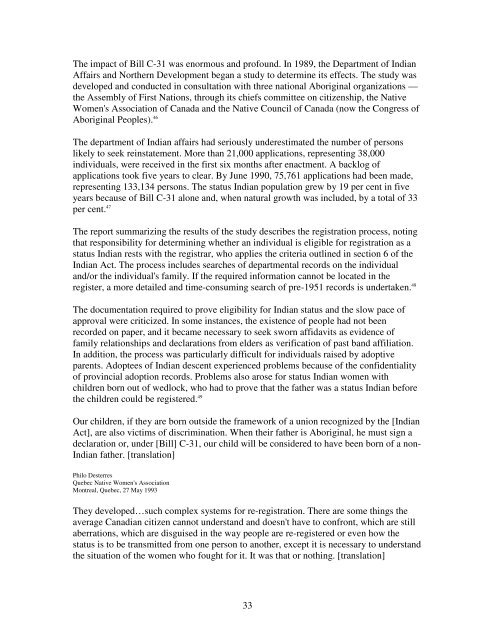2. Women's Perspectives - Christian Aboriginal Infrastructure ...
2. Women's Perspectives - Christian Aboriginal Infrastructure ...
2. Women's Perspectives - Christian Aboriginal Infrastructure ...
You also want an ePaper? Increase the reach of your titles
YUMPU automatically turns print PDFs into web optimized ePapers that Google loves.
The impact of Bill C-31 was enormous and profound. In 1989, the Department of Indian<br />
Affairs and Northern Development began a study to determine its effects. The study was<br />
developed and conducted in consultation with three national <strong>Aboriginal</strong> organizations —<br />
the Assembly of First Nations, through its chiefs committee on citizenship, the Native<br />
<strong>Women's</strong> Association of Canada and the Native Council of Canada (now the Congress of<br />
<strong>Aboriginal</strong> Peoples). 46<br />
The department of Indian affairs had seriously underestimated the number of persons<br />
likely to seek reinstatement. More than 21,000 applications, representing 38,000<br />
individuals, were received in the first six months after enactment. A backlog of<br />
applications took five years to clear. By June 1990, 75,761 applications had been made,<br />
representing 133,134 persons. The status Indian population grew by 19 per cent in five<br />
years because of Bill C-31 alone and, when natural growth was included, by a total of 33<br />
per cent. 47<br />
The report summarizing the results of the study describes the registration process, noting<br />
that responsibility for determining whether an individual is eligible for registration as a<br />
status Indian rests with the registrar, who applies the criteria outlined in section 6 of the<br />
Indian Act. The process includes searches of departmental records on the individual<br />
and/or the individual's family. If the required information cannot be located in the<br />
register, a more detailed and time-consuming search of pre-1951 records is undertaken. 48<br />
The documentation required to prove eligibility for Indian status and the slow pace of<br />
approval were criticized. In some instances, the existence of people had not been<br />
recorded on paper, and it became necessary to seek sworn affidavits as evidence of<br />
family relationships and declarations from elders as verification of past band affiliation.<br />
In addition, the process was particularly difficult for individuals raised by adoptive<br />
parents. Adoptees of Indian descent experienced problems because of the confidentiality<br />
of provincial adoption records. Problems also arose for status Indian women with<br />
children born out of wedlock, who had to prove that the father was a status Indian before<br />
the children could be registered. 49<br />
Our children, if they are born outside the framework of a union recognized by the [Indian<br />
Act], are also victims of discrimination. When their father is <strong>Aboriginal</strong>, he must sign a<br />
declaration or, under [Bill] C-31, our child will be considered to have been born of a non-<br />
Indian father. [translation]<br />
Philo Desterres<br />
Quebec Native <strong>Women's</strong> Association<br />
Montreal, Quebec, 27 May 1993<br />
They developed…such complex systems for re-registration. There are some things the<br />
average Canadian citizen cannot understand and doesn't have to confront, which are still<br />
aberrations, which are disguised in the way people are re-registered or even how the<br />
status is to be transmitted from one person to another, except it is necessary to understand<br />
the situation of the women who fought for it. It was that or nothing. [translation]<br />
33
















